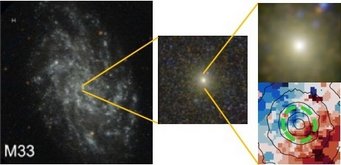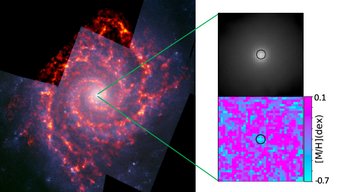
The Formation of Nuclear Star Clusters
The projects aims at using high-spatial-resolution integral-field spectroscopy to extract the stellar-kinematic and population properties of nuclear star clusters (NSCs) and their surroundings, aiming at unveiling their dominant formation mechanisms.

This work presents the resolved kinematics of 11 nearby galactic nuclei, at parsec scale, in early and late-type galaxies. The balance between ordered rotation and random motions shows that nuclear regions in late-type galaxies are on average more rotation dominated, and the formation of nuclear stellar structures is potentially linked to the presence of gas funneled to the center. Early-type galaxies, in contrast, tend to display slowly rotating NSCs with lower ellipticity. However, some exceptions suggest that in specific cases (e.g., massive NSCs), early-type hosts can form NSCs in a way similar to spirals (Pinna et al., 2021).
Data: NIFS/GeminiNorth, SINFONI/VLT.
For more information, please contact Francesca Pinna.

This work aims at extracting the stellar populations of nuclear star clusters (NSCs) in a sample of five late-type galaxies from the PHANGS-MUSE survey, and comparing them to the resolved properties of the host galaxies.
These spiral galaxies have stellar masses above 109 MSun, a mass range not explored for late types, and where early-type galaxies host NSCs that are more metal-rich than their hosts, suggesting a predominant in-situ formation.
We aim at testing whether NSCs in relatively-massive spirals are more metal-poor than their early-type counterparts (as suggested by our pilot study) and than their hosts.
This will unveil whether different formation channels dominate in different Hubble types or similar mechanisms may lead to different NSC properties depending on the host evolution.
The spatial distribution of the molecular and ionised gas from the PHANGS survey will add important insights on the potential role of gas inflow in the NSC formation in spiral galaxies.
Data: MUSE/VLT
For more information, please contact Francesca Pinna.
The formation and evolution of nuclear star clusters (NSCs) is directly linked to the evolution of their host galaxies. Two formation mechanisms were proposed: dissipationless globular cluster migration and in-situ star formation driven by dissipation of gaseous clouds. Their relative contribution to present-day NSCs is still unclear as they depend on unknown details of globular cluster formation and spatial distribution, as well as on host galaxy dynamics across cosmic time. Observationally, one avenue to investigate the build-up of NSC is to analyse imaging data of NSCs. For example, a spatially varying spectral energy distribution hints at in-situ star-formation, and a correlation between the NSC effective radius and NSC stellar mass probes globular cluster migration. In addition, both the occupation fraction of NSCs as well as NSC structural parameters seem to correlate with host galaxy properties such as stellar mass, morphological type, and environment. We use high-resolution Hubble Space Telescope imaging data to derive these parameter sets for a large number of NSCs in the nearby Universe. The aim of our study is both to characterise individual NSCs to constrain their evolutionary path, and to find correlations to host galaxy properties in hopes of understanding galaxy evolution in greater detail.
For more information, please contact Nils Hoyer.

